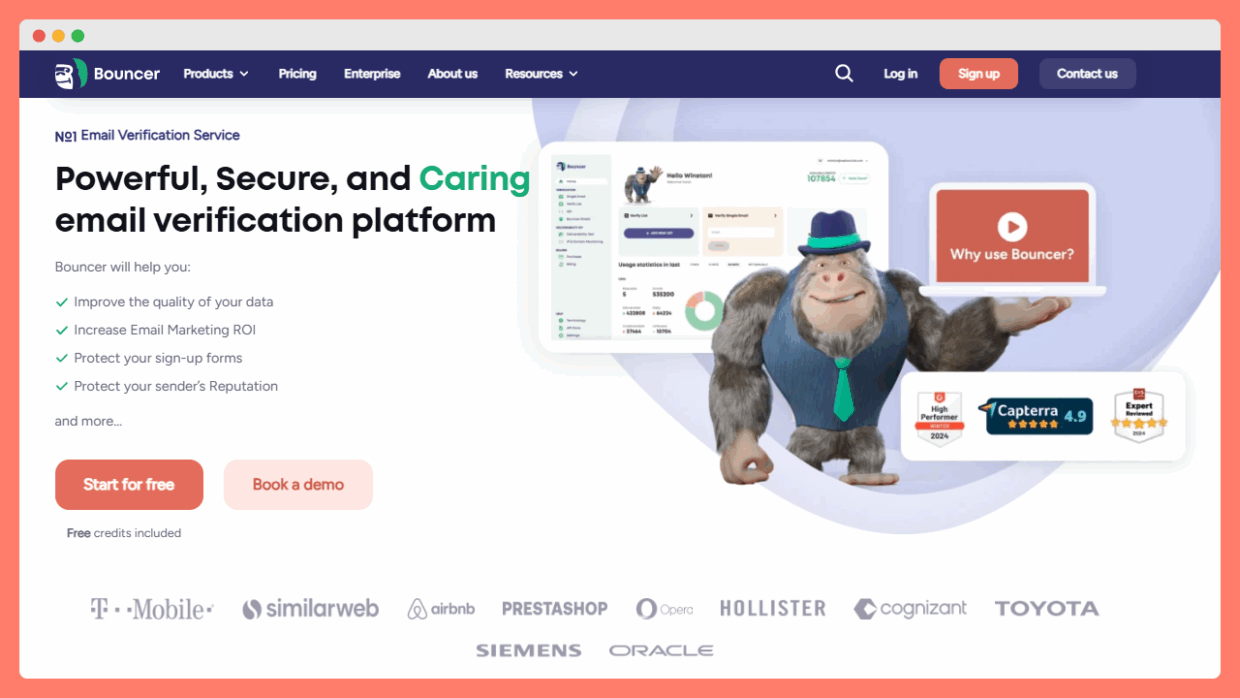That’s where tools like VerifyEmailAddress.org step in. This long-standing, no-frills email verifier lets you verify email addresses for free — one by one or in bulk — to check if an email address exists before your message gets lost in the void.
Let’s dig into what this email verification tool offers, how it works, and what you should (and shouldn’t) expect.
What is VerifyEmailAddress.org?
VerifyEmailAddress is one of those old-school web tools that looks simple because… it is. No login required. No flashy dashboards. You enter the email address, click “Verify,” and boom — you get a status update telling you if the email address is valid, deliverable, or just a digital ghost.

It works by checking MX records, pinging the recipient’s SMTP server, and attempting to confirm that the recipient address can actually receive emails. Think of it as knocking on a door before dropping off a package.
It’s been around since 2010 and is used by everyone from solo email marketers to list brokers and data teams who just want to stop sending emails into a black hole.
How does it actually verify an email?
Behind that single input box lies a surprisingly layered verification process:
- First, it checks if the email address format is correct (no “@gmial.con” here).
- Then it validates the domain to see if there are working mail servers ready to accept email.
- It contacts the recipient’s SMTP server and asks, “Hey, does this email ID exist?”
- If the server replies “yes,” the email passes. If it’s silent or throws an error, it probably won’t land in the recipient’s inbox.
The tool also checks for disposable email services, full inboxes, and obvious spam traps — which can help reduce bounce rates and protect your sender reputation.
This process isn’t magic, but for a free email checker, it’s solid.
Free email verification tool… really? What’s the catch?
There isn’t one. You can verify a single email for free directly from the website, no sign-up form, no account, no need to remember yet another password. Just verify emails in just a few clicks.
If you’re sitting on a massive email list, there’s a bulk email verifier option too. You upload your file, let the tool work through the addresses, and download the results.
There’s also a Trace Email tool that claims to uncover details like name, social media profiles, and more — but results may vary, and it edges into “people search” territory, which may not be what your average email marketer is after.
Where it fits — and where it doesn’t
VerifyEmailAddress is ok for:
- Checking one-off emails before sending
- Validating sign-up form submissions manually
- Spot-checking a small batch of contacts
- Confirming email address validity before importing into Google Sheets or your CRM
- Identifying soft bounces and obvious fakes (like “notarealemail@domain.lol”)
But let’s be real — it’s not designed for:
- Deep automation or smart filtering
- Teams looking for an email validation API
- Integration with tools like Mailchimp or HubSpot
- Scoring email quality or assigning risk levels (e.g. role-based, full mailbox, greylisted)
If your workflow involves multiple tools, or if your business depends on bulletproof email deliverability, this may feel too lightweight.
What could be better than Verifyemailaddress for email deliverability?
To be fair, VerifyEmailAddress hasn’t changed much visually since the early 2010s — and it shows. The UI is functional, but a refresh wouldn’t hurt. There’s no reporting, no sorting, and no pretty graphs — which is either a bonus or a limitation, depending on your expectations.
It also doesn’t give detailed response codes from SMTP servers, which means you’re trusting the tool’s backend logic more than reviewing diagnostic data.
And while there’s talk of reliability and accuracy, there’s no public-facing documentation to prove how well it performs against bounce rates or real delivery data — so you’re taking it on faith.
Alternatives to consider
If you’re starting to scale, or need richer feedback from your email checker, tools like Bouncer might be worth exploring.

Bouncer offers:
- Smarter status labels (e.g. disposable, risky, role-based)
- Bounce predictions before you use credits
- Bulk list upload with rich exports
- Integrations with CRMs and email marketing platforms
- GDPR-compliant email verification across multiple levels of checks
It’s ideal if you want to clean data and optimize email deliverability at the same time — not just guess whether an email address is valid.

👉 Curious? Try Bouncer for free
Myth Busting: Email Verification Misconceptions (and What’s Actually True)
Email verification seems simple on the surface, but there are a few persistent myths floating around that can trip up even experienced users. Let’s clear a few of them up — with facts, not folklore.
Myth #1: If an email is from Gmail or Yahoo, it’s definitely valid.
Not quite.
While Gmail and Yahoo are major providers, not every free email address created through them is active or monitored. Many are abandoned or used once and forgotten. Others are used as disposable email addresses to bypass sign-ups or filters.
A good email validator checks whether the address is structured correctly, the email servers are responding, and if the recipient’s inbox can accept new mail — not just which provider hosts it.
Myth #2: You only need to validate emails when you first collect them.
Nope.
Email addresses can go stale over time. People switch jobs, abandon inboxes, or change providers. Removing invalid contacts once isn’t enough if you send regularly. Ongoing checking of email addresses is key to maintaining list health — especially if you want messages delivered successfully to the intended recipient every time.
Myth #3: If the format is correct, the email must be real.
Wrong again.
Just because an address looks fine (e.g. name123@gmail.com) doesn’t mean it exists. Only a proper email validator can confirm whether the email servers accept mail for that address. Format checks are the first layer — real verification digs deeper to see if the address is real, reachable, and reliable.
Final thoughts
There’s something refreshing about a free tool that just… works. VerifyEmailAddress gives you a fast, no-nonsense way to verify an email, whether you’re checking one contact or a whole list.
It’s not built for marketing teams with complex pipelines or compliance goals. But if you’re dealing with cold outreach, manual imports, or you just want to keep bad email addresses out of your system, it’s a practical first step.
Still, use Bouncer to confirm what’s legit, reduce bounce rates, and improve deliverability without jumping through hoops. If you need more than that — well, Bouncer has tools for that too.
FAQ
What is a disposable email address and why should I avoid it?
A disposable email address is a temporary inbox often used to bypass sign-up forms or avoid spam. These addresses are short-lived and almost never checked by the user. Keeping them on your email list can increase bounce rates and hurt your sender reputation, so it’s best to filter them out using an email verifier.
How does an accurate email verification API work?
An email verification API allows you to automatically check email addresses in real-time as users enter them into your forms or CRM. It connects to the email servers, verifies structure, domain, and inbox activity, and returns a status — valid, invalid, risky, or unknown. It’s a must-have for teams managing large lists or frequent data imports.
What’s the difference between an email validator and email verifier?
An email validator usually checks the structure and domain of an email (e.g. does it follow the right format? does the domain exist?). A full email verifier goes deeper, contacting the recipient’s server to confirm whether the email can actually receive messages. Ideally, your tool does both.
Can I verify a bulk email list at once?
Yes. Most verification tools offer bulk email features, allowing you to upload an entire file and run checks on all entries in one go. This is the most efficient way of removing invalid or risky email addresses and helps reduce bounce rates significantly before launching a campaign.

